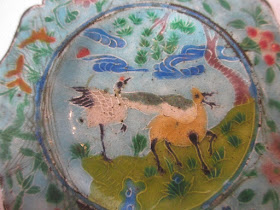Recently these two pairs of little beads turned up:
 |
| Oddly, the bead in the upper left features what looks like a tiny handmade screw or headpin patching a hole just above and to the left of the existing hole. |
 |
| The pine tree, swirling clouds with red sun, green hill with grassy shoots and a pond, all match the iconography of the beads. |
 |
| Design is created by repuosse engraving on the reverse side. Dish is small, about 3" in diameter. |
What I think makes these small dime-sized beads particularly rare is that design is rendered not with the more usual repousse technique or with twisted wires, but with tiny wires thinner than horsehair. My guess is that the wires were bent in pairs, hence the symmetry in the designs for each pair. The positioning and size of the holes seems careless and awkward, which is too bad considering the level of skill it took to create the tiny cloisonne designs.
The beads were on what appeared to be hand-made eye pins, which I removed. I wondered if the beads had originally been made for a Chinese person, and then got recycled into a necklace tailored to foreign taste, such as this piece that seems likely to be from the 1930s:







No comments:
Post a Comment